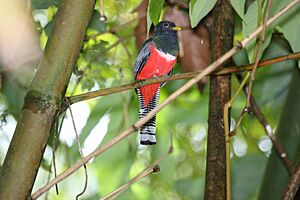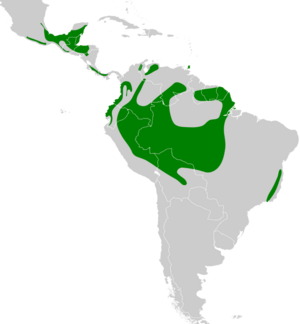Collared trogon facts for kids
Quick facts for kids Collared trogon |
|
|---|---|
 |
|
| Male | |
| Conservation status | |
| Scientific classification | |
| Genus: |
Trogon
|
| Species: |
collaris
|
 |
|
The collared trogon (Trogon collaris) is a beautiful bird. It belongs to the Trogonidae family. This family also includes the famous quetzals. You can find these birds in Mexico and all across Central America. They also live in northern South America.
Contents
What is a Collared Trogon?
The Collared Trogon is a type of bird. It is known for its bright feathers. Scientists group animals into different types. These types are called subspecies. Different groups of scientists have slightly different ideas. They list different numbers of Collared Trogon subspecies.
For example, the International Ornithological Committee (IOC) lists 10 subspecies. The Clements taxonomy also lists 10. One subspecies, T. c. aurantiiventris, was once seen as its own species. But now, most scientists agree it is a Collared Trogon.
Another group, BirdLife International, lists eight subspecies. This shows how scientists keep learning. They update their ideas as they find out more.
How to Spot a Collared Trogon
Collared Trogons are medium-sized birds. They are about 25 to 29 centimeters (10 to 11 inches) long. They weigh about 41 to 64 grams (1.4 to 2.3 ounces). Both male and female birds have a black face and throat.
Male Collared Trogons
Males are very colorful. Their head, back, and rump are a shiny metallic green. Their wings look black and white. They have a metallic green chest. A white band separates this from their bright red belly. The top of their tail is green with a black tip. The underside of their tail has black and white stripes.
Female Collared Trogons
Females are a bit different. Their green parts are more of an olive-brown color. Their closed wings are brown with black patterns. Their belly is a duller red than the male's. The underside of their tail is gray. It has a few black stripes and white tips.
Where Do Collared Trogons Live?
Collared Trogons live in many places. They are found from Mexico down to northern South America. Different subspecies live in different areas.
- T. c. puella lives from central Mexico to western Panama.
- T. c. underwoodi is found in northwestern Costa Rica.
- T. c. aurantiiventris lives from central Costa Rica to western Panama.
- T. c. extimus is in eastern Darién Province in Panama.
- T. c. heothinus lives in Panama's Serranía del Darién.
- T. c. virginalis is found from western Colombia through western Ecuador to northwestern Peru.
- T. c. subtropicalis lives in central Colombia.
- T. c. exoptatus is in northern Venezuela. Some think it is also in Trinidad & Tobago.
- T. c. collaris lives east of the Andes mountains. This is from Colombia south to northern Bolivia. It also goes east through the Guianas and much of west central Brazil. Some also think it is in Trinidad & Tobago.
- T. c. castaneus is found from southeastern Colombia south to eastern Peru. It also lives in northern Bolivia and into northwestern Brazil. You can also find it in eastern Brazil.
These birds like humid evergreen forests. These are forests that stay green all year. They live in both old, untouched forests (called primary forest) and newer, regrown forests (called secondary forest). In Mexico and Central America, they also live in humid montane forests. These are forests on mountains. They can be found high up, sometimes over 2,400 meters (7,900 feet) high!
How Collared Trogons Behave
Collared Trogons usually sit on branches. They like to be in the middle part of the forest. This is between the lower plants and the tops of the trees. They are often seen alone or in pairs. Sometimes, small groups gather when it's not breeding season.
What Collared Trogons Eat
Collared Trogons eat small fruits. They also eat many kinds of insects. These include caterpillars, crickets, and beetles. They sometimes fly near groups of other birds. But they usually don't join in with them.
How Collared Trogons Raise Their Young
The breeding season for Collared Trogons changes. It depends on where they live. It can start as early as November in some places. In others, it might start in April.
They build their nests in holes. These holes are often in rotting wood. They also use nests made by termites. The hole is often shallow. This means you can see much of the bird when it's inside. They usually lay two eggs. Both the male and female birds take turns sitting on the eggs. They both also help care for the young birds.
Collared Trogon Sounds
The song of the Collared Trogon is different in various places. Birds in Mexico and Central America sing a sad-sounding "kyow'-kyow" or "caow' caow". They also have a faster "kyow kyow-kyow".
In South America, their songs are softer. They sound like a series of gentle whistles. It often starts with a quick, stuttered note. It sounds like "whi'whi whew-whew-whew". They also make calls like a long "charr" or a snorting "chur-r-r-r".
Are Collared Trogons in Danger?
The IUCN (International Union for Conservation of Nature) checks on animals. They have said the Collared Trogon is of "Least Concern." This means they are not worried about this bird becoming endangered soon. There are many Collared Trogons in the world. They also live across a very large area.


